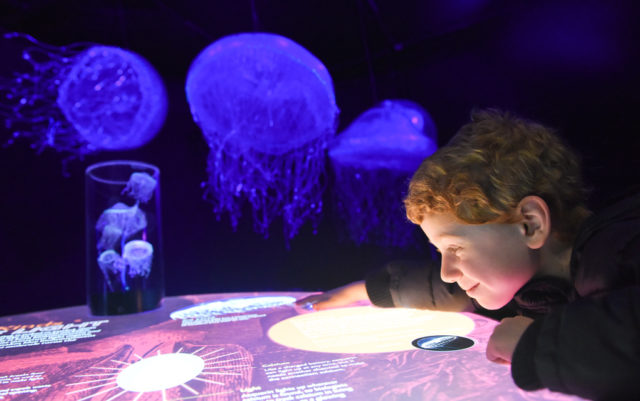
A few years ago, the creators of the Creatures of Light exhibit at the Denver Museum of Nature and Science saw something unusual in a photo of a coral reef in the Bahamas. They noticed an eel glowing bright green; it was the first bony fish they had seen fluoresce.
“We didn’t know that,” says Brian Hostetler, educator for the exhibit. “They fluoresced on the inside and the out. The science is so new, we had no idea.”
Creatures of Light highlights organisms that often don’t get enough attention, Hostetler says, displaying a wide range of animals, fungi and minerals on land and in sea, all that glow for different reasons.
“Things that light up or things that glow are seen as an oddity of nature rather than the rule. I think it’s easy for people to forget that in a certain parts of the ocean, especially the deep sea, 80 to 90 percent of the animals down there light up, and that’s the only way they communicate,” Hostetler says. “Beyond that, there’s a number of different organisms that light up on the surface of the land and in some random spots. But the problem is you can’t see them that well unless it’s nighttime. If humans were a bit more nocturnal, we’d probably be more familiar with them.”
The show cites many reasons for animals to produce light: protection, reproduction, camouflage and luring prey. Creatures glow at different times in their life — adult fireflies use their light for mating purposes while glow worm larvae found in the caves of New Zealand use light to catch their next meal. The single-celled organisms dinoflagellates use light almost like a burglar alarm — when a predator attacks, they turn on their light to attract bigger predators to eat their attackers.
The show also teaches the difference between bioluminescence and fluorescence. As the exhibit states, “Bioluminescence is visible light generated by a living organism through a chemical reaction. … Fluorescence comes from molecules that react to light in an unusual way.” Animals like fireflies create their own light, while certain rocks and corals reflect off a different colored light when hit with a black light.
Both types of natural light have been adapted for scientific research. Hostetler explains that researchers have injected certain fish with genes from jellyfish and sea anemone in order to make them glow. Then scientists release these fish back into a waterway as a means to observe pollution. If the fish dies and washes up downstream, it’s easier to detect because of its fluorescence.
This process of cellular tagging has become widely used for medical research. Colored protein extracted from jellyfish can be injected into living cells without altering their structure. Acting almost as a dye, researchers can observe the processes of cells and then in turn learn more about certain diseases. Mouse studies used to analyze Alzheimer’s are one example of this application, Hostetler says.
“So researchers would put this colored protein into a particular type of cell and then they would see where these cells are clumping in the brain. They’d see clusters with tangles in them and that’s what’s behind Alzheimer’s disease — these tangles of cells,” he says. “They’ve just made some of those discoveries in the last 10 or 15 years. Researchers at Anschutz and CU are using this constantly. This is the norm now for genetics and neuroscience research.”
As natural animal light is aiding in certain scientific advancement, some questions still remain as to why certain organisms glow. One part of the exhibit features a look at glowing mushrooms, but Hostetler says there’s no definitive proof as to why the mushrooms give off light.
“Some experts think it’s to attract insects to come land on them, and then they’d spread their spores to other areas. So [the function would be] to help the fungus colonize,” he says. “But we’re not specifically sure.”
Creatures of Light has also led to some local experimentation on the Denver museum’s own collection. Hostetler says they recently put a black light on an iguana that’s been in their possession for more than 40 years and noticed a completely different pattern on its skin.
“Because of this exhibit, we’re going through our collection with UV lights and seeing things glow and light up that we never thought would,” he says.
“There’s a lot we’re trying to figure out still,” he continues. “But we’ll get there.”
On the Bill: Creatures of Light. Denver Museum of Nature and Science. 2001 Colorado Blvd., Denver. Through June 10.














